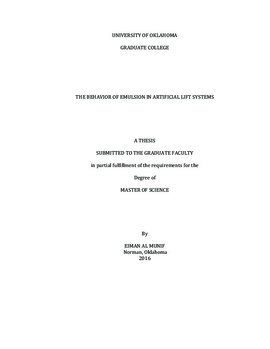| dc.contributor.advisor | Fahes, Mashhad | |
| dc.contributor.author | Al Munif, Eiman | |
| dc.date.accessioned | 2016-08-22T14:08:58Z | |
| dc.date.available | 2016-08-22T14:08:58Z | |
| dc.date.issued | 2016-08 | |
| dc.identifier.uri | https://hdl.handle.net/11244/44938 | |
| dc.description.abstract | The gas lift system and ESP are used to enhance oil production from a well. The basic principle of gas lift technique is reducing the gravity component of the pressure by injecting gas, thus increasing the oil production from a well. An ESP, on the other hand, boosts the production of fluid after exposing it to great centrifugal forces and rotations inside each pump stage that leads to a change of kinetic energy to potential energy and thus increasing pressure. Both techniques aid in lifting the fluid to surface and improve production. Previous investigations underlined the effect of both systems on three phase flow in vertical pipes but few studied the behavior of emulsion inside these two methods.
In a vertical production tubing, water and oil flow together forming a liquid mixture. Under some circumstances when emulsifying agents are present, the emulsion is formed composed of a dispersed phase in a continuous phase either oil drops in water or water drops in oil emulsion. The viscosity of formed emulsion increases compared to the viscosity of each phase.
In this thesis, the influence of gas injection on water-oil emulsion in a vertical pipe, and the effect of a centrifugal pump on emulsion properties were investigated. The main focus was on the pressure gradient changes.
Experiments were conducted in the laboratory. The first phase of the experiment was to build the vertical flow loop and test it with water. The two phase (water-air) flow experiments revealed the compatibility of the system with our needs where gas injection reduced the pressure drop as predicted by correlations.
The second phase of experiments was lifting oil. Further measurements were done on mineral oil to confirm that the centrifugal pump and the gas injection would operate well with a viscous fluid and that we can reduce the gravitational part of the pressure drop.
Finally, the third phase of the experiments included running the emulsion through a centrifugal pump and exposing it to gas injection to investigate pressure drops. The gas lift data suggest that the technique becomes less efficient in the presence of emulsions. | en_US |
| dc.language | en | en_US |
| dc.subject | emulsion, ESP, Gas Lift, artificial lift | en_US |
| dc.title | THE BEHAVIOR OF EMULSION IN ARTIFICIAL LIFT SYSTEMS | en_US |
| dc.contributor.committeeMember | Teodoriu, Catalin | |
| dc.contributor.committeeMember | Pournik, Maysam | |
| dc.date.manuscript | 2016-08-17 | |
| dc.thesis.degree | Master of Science | en_US |
| ou.group | Mewbourne College of Earth and Energy::Mewbourne School of Petroleum and Geological Engineering | en_US |
| shareok.nativefileaccess | restricted | en_US |
